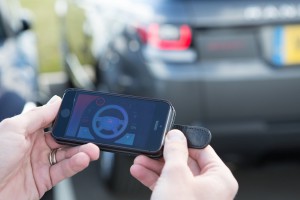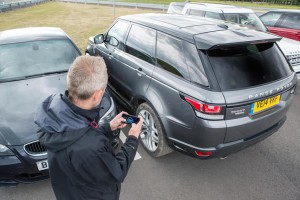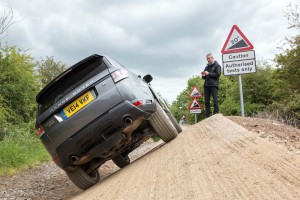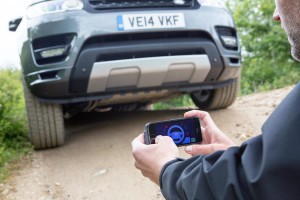
Jaguar Land Rover developed a new app, which is still just a prototype, allowing for remote-control driving of the sport-utility.
As part of a push to introduce new technologies into its vehicles, Jaguar Land Rover has developed a smartphone app that allows users to pilot the vehicle while outside the vehicle.
Before folks begin imagining themselves as James Bond with his remote-controlled BMW 750iL in “Tomorrow Never Dies,” Jaguar’s version has some substantial limits, including one major disappointment: no roof-mounted rocket launcher.
The app includes control of steering, accelerator and brakes as well as changing from high and low range. This would allow the driver to walk alongside the car, at a maximum speed of 4 mph, the company notes.
The remote control function will only operate if the user is within 10 meters of the car and if the smart key can be detected. The system will stop the vehicle if the driver moves out of range or gets too close.

Can't get into your Land Rover to back it out of the parking spot? No problem! There's an app for that!
Still in the prototype stage, the system lets a person simply whip out their smart phone and pilot their Range Rover Sport – Jaguar’s test vehicle – out of a tight parking space or walk alongside the SUV while helping it traverse a rocky slope.
(Jaguar working up second SUV. For more, Click Here.)
Long known for luxury, Jaguar Land Rover is on a bit of a technological tear lately. In addition to the remote control app, the company debuted its Multi-Point Turn vehicle as well.
A Range Rover Sport equipped with the technology is capable of autonomously making a 180-degree turn in the road and point the car in the opposite direction. This autonomous vehicle could extricate itself from the most difficult situations, such as a dead-end roads or congested car parks, as well as performing many drivers’ least favorite move – the three-point turn in a busy street or parking structure.
The system uses sensors to assess available space and to avoid pedestrians, vehicles and other objects as well as handling gear selection, steering, braking and acceleration to make as many forward and backwards movements as necessary to complete the turn.
The maker is also moving beyond simply making turning and extricating vehicles from tight parking spaces easier. Jaguar Land Rover is in the midst of its “Sixth Sense” research project that aims to incorporate technology used in the aerospace and medical industries into the automotive space … specifically the interior cabin space.
(Click Here for details about JLR’s profitable 2014.)
“The car is becoming more intelligent and more able to utilize cutting-edge sensors. These research projects are investigating how we could exploit this for the benefit of our customers and other road users,” said Dr. Wolfgang Epple, Jaguar Land Rover director of Research and Technology.

Using a smartphone app, Land Rover drivers can tackle difficult terrain, but keep themselves from harm.
“One key piece of new research is to see how we could measure brainwaves to monitor if the driver is alert and concentrating on driving. Even if the eyes are on the road, a lack of concentration or a daydream will mean the driver isn’t paying attention to the driving task. They may miss a warning icon or sound, or be less aware of other road users so we are looking at how we could identify this and prevent it causing an accident.”
Jaguar Land Rover calls this its “Mind Sense” research project. Additionally, the company working other technology-based options to improve a driver’s experience, including:
- A Wellness Seat that monitors a driver’s heartbeat and respiration to make sure he or she is all right to drive physically.
- A Haptic Accelerator pedal that vibrates and creates resistance to tell a driver he or she is driving too fast or prevent a low-speed collision in traffic.
- A Predictive Infotainment Screen with mid-air touch to that can tell what button a driver intends to push and activates it.
(To see more about the Infiniti Q30 debuting at Frankfurt, Click Here.)
“The driver will instinctively look at the infotainment screen or dashboard when pressing buttons to select navigation, music or the telephone. It’s intuitive. So our research is looking at how we could take a current infotainment screen and increase the speed and efficiency of this interaction to minimize the time the driver’s eyes are away from the road and their hand is off the steering wheel.”


Well the good thing is after it runs over the driver…it will stop. When you have little to offer you dream up gimmicks for the gullible.
They claim it won’t run over pedestrians. Since the lawsuits that would follow the first couple times something like that might happen, I’m inclined to believe them.
Yes I read that but don’t believe everything an auto maker claims. Sensors detecting the operator being too close could be confused and a tragedy could ensue. Time will tell if they got the toys properly protected. To me this is just a gimmick for the clueless to use to impress their friends after they’ve all had too much alcoholic beverages.